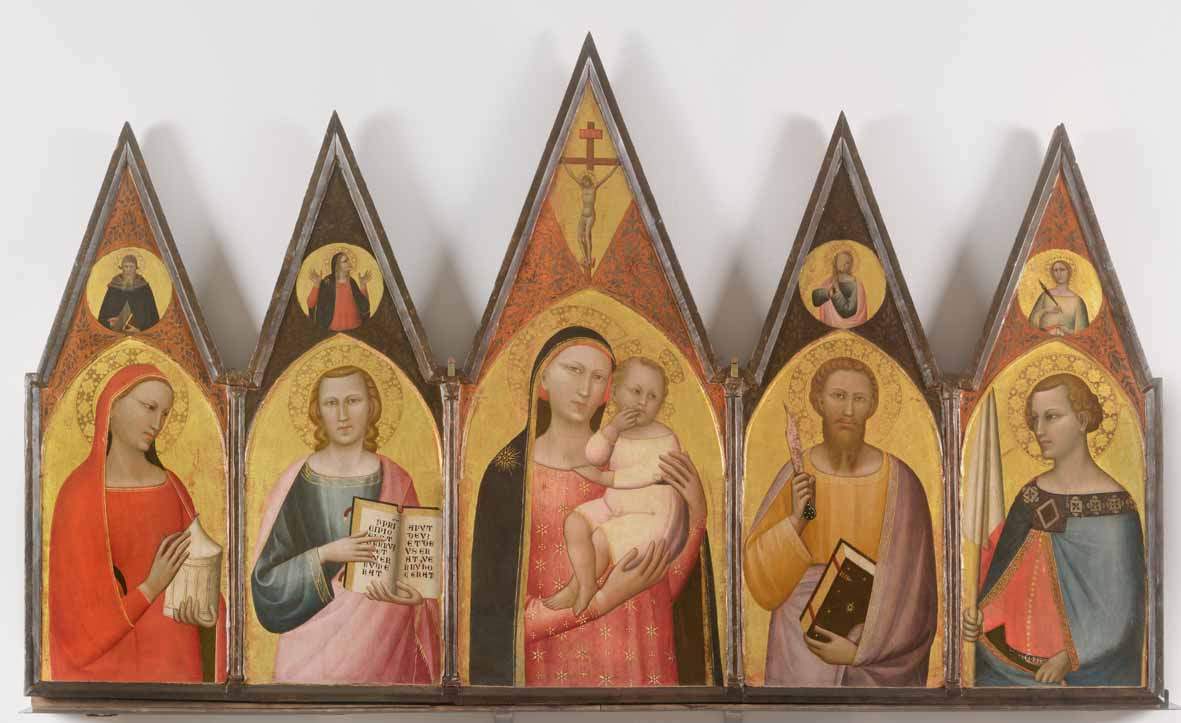The city of Fabriano is dedicating an exhibition, from Oct. 15, 2021 to Jan. 30, 2022 at the Pinacoteca Civica, to one of its greatest artists, Allegretto Nuzi (Fabriano, c. 1315 - 1373), one of the leading figures of the 14th century in the Marche region. The exhibition, entitled Gold and Color in the Heart of the Apennines. Allegretto Nuzi, curated by Andrea De Marchi and Matteo Mazzalupi, delves into the career of the artist, a native of Fabriano and a Tuscan by training, who worked permanently in Fabriano from 1347 until his death in 1373, executing a large number of works of various kinds, from altarpieces for private worship to large-scale polyptychs and fresco cycles. The quality of Allegretto Nuzi’s gold backgrounds was, from the very beginning and even more so in the centuries that followed, extraordinarily successful, and these works were contended for by admirers and collectors, ending up in important museums and collections not only outside Fabriano but also in Italy, so much so that no individual devotional paintings remain in our country.
The exhibition is the first entirely dedicated to Allegretto Nuzi, is promoted by the City of Fabriano and the Soprintendenza Archeologia Belle Arti with the collaboration with the contribution of several Italian and international institutions, and succeeds in the great feat of bringing back to Fabriano some 30 works by the great artist lent for the occasion, including eleven panels from foreign museums. The painter’s masterpieces are also flanked by loans from other artists to evoke the unique artistic moment in Fabriano in the second half of the 14th century: these are mainly sculptures by other artists in the area, which in their colors are clearly influenced by Allegretto and his school. It is precisely this widespread “tracing back to the origin” that also makes it possible to bring together long-dispersed parts of polyptychs, to compare works that clearly outline the path of a master who can rightfully be called such. The dispersion and consequent lack of direct knowledge of his works had in fact relegated Allegretto Nuzi to a seemingly local role.
“On the strength of his Tuscan upbringing,” writes Andrea De Marchi, “Nuzi exerted an enormous influence, between Umbria and Marche, in sodality with his countryman and emulous Francescuccio di Cecco, importing a calm and monumental language, matured on comparison with the expressive tenderness of Lorenzetti in Siena and with the caressing volumes of Florentine Giottesque painters such as Maso di Banco and Bernardo Daddi. Allegretto introduced to the Marche region as yet unknown types of complex polyptychs and exquisite altarpieces for individual devotion. In iconographies he was an innovator, contributing to the spread of the Madonna of Humility in the Adriatic area, bending the Passion stories to original and touching interpretations. In pictorial techniques he was an experimenter, combining with great freedom punches to compose the floral decorations of the nimbuses and unfolding shimmering textiles worked with patterns of birds and turtles, with sgraffito color to bring out the gold of the background. Da Fabriano dialogued closely with the best Florentine painters of his age, with Puccio di Simone, whom he brought to work with him between 1353 and 1354, with his brothers Andrea and Nardo di Cione, the Orcagna. He knew how to impale mural cycles of rare freshness, capable of combining the simplified grandeur of the whole and the narrative immediacy of detail. The principal ones are still preserved in the churches of Fabriano, in Santa Lucia Novella, of the Dominicans (chapel of San Michele and Sant’Orsola, sacristy), and in the tribune of San Venanzio.”
The tribune of the church of San Venanzio, now the cathedral, erected in the 1460s, is a misunderstood pinnacle of Central Italian Gothic architecture and has been the subject of a virtual restitution based on a rigorous survey, which can thus be experienced in immersive form as an appropriate introduction to the visit in the present cathedral, where the remains of the frescoes that lined the chapels of San Lorenzo, San Giovanni and the Holy Cross survive, stripped by later transformations. The exhibition, thanks to collaboration with the Diocese of Fabriano - Matelica, also features a small section at the Diocesan Museum and in the cathedral of San Venanzio itself, where a wooden Calvary with mourners is reconstructed. The exhibition in Fabriano is also connected to the exhibition on Ottaviano Nelli in Gubbio, curated by Andrea De Marchi himself and Maria Rita Silvestrelli and promoted by the Municipality of Gubbio and the Regional Directorate of Museums of Umbria.
Visiting hours: Tuesday through Sunday from 10 a.m. to 1 p.m. and 3 p.m. to 6 p.m. Single entrance ticket € 5.00, entrance for groups with more than 20 people € 4.00, entrance for school groups with more than 15 people € 3.00, entrance over 65 € 4.00, entrance under 18 € 3.00, free for handicapped persons and their companions, group companions, journalists, children under six, residents of the Municipality of Fabriano. Integrated ticket with Paper Museum and Guelph Museum: € 12. Catalog: Silvana Editoriale. For info: phone 0732 250658, email oroecolore@comune.fabriano.an.it, website www.pinacotecafabriano.it.
Allegretto Nuzi, Madonna and Child, St. Mary Magdalene, St. John the Evangelist, St. Venantius (tempera on panel, 118 x 200 cm; Fabriano, Pinacoteca civica “Bruno Molajoli”)
 |
| Allegretto Nuzi, protagonist of the 14th century in the Marche region, is on display in Fabriano |
Warning: the translation into English of the original Italian article was created using automatic tools. We undertake to review all articles, but we do not guarantee the total absence of inaccuracies in the translation due to the program. You can find the original by clicking on the ITA button. If you find any mistake,please contact us.